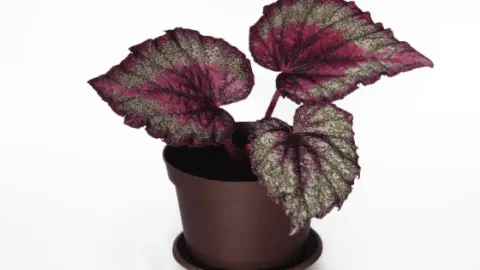This article is about how to care for Begonia rex. The Begonia is a stunning houseplant with colored leaves that grows from a rhizome.
The original Rex Begonia had dark leaves with wonderful silver designs.
The original plant came from India.
This plant can come in various colors depending on how it’s bred. But most come with leaves in a pretty pink with blackened edges. Or pink with silver edges.
Like most Begonia species, such as Begonia maculata, the Begonia rex is easy to care for.
Table of Contents
Begonia Rex Takeaways
| Species | Begonia rex |
| Synonyms | Beefsteak geranium,King begonia,painted-leaf begonia,Rex begonia. |
| Family | Begoniaceae |
| Genus | Begonia |
| Growth | Bushy |
| Height | 1.5 feet |
| Width | 0.5 feet |
| Soil | Potting soil, peat moss, perlite, vermiculite |
| Watering | Water every 5 to 7 days |
| Light | Bright indirect |
| Temperature | 65 to 75°F |
| Humidity | 50-46% |
| Fertilizer | Fertilize times per month |
| Propagation | Leaf cuttings, root division |
| Toxicity | Toxic to pets such as cats and dogs and horses. It contains soluble calcium oxalates. |
Caring for a Begonia rex Indoors
A Begonia rex needs porous fast-draining soil using peat moss, perlite, and vermiculite. It needs bright, but indirect sunlight and the soil should always be slightly moist. Water when the top 1” of soil becomes almost dry about once a week. A temperature between 65-75°F (18-24°C) is ideal. Provide 50% humidity. Use regular houseplant fertilizer tri-weekly diluted to half-strength.
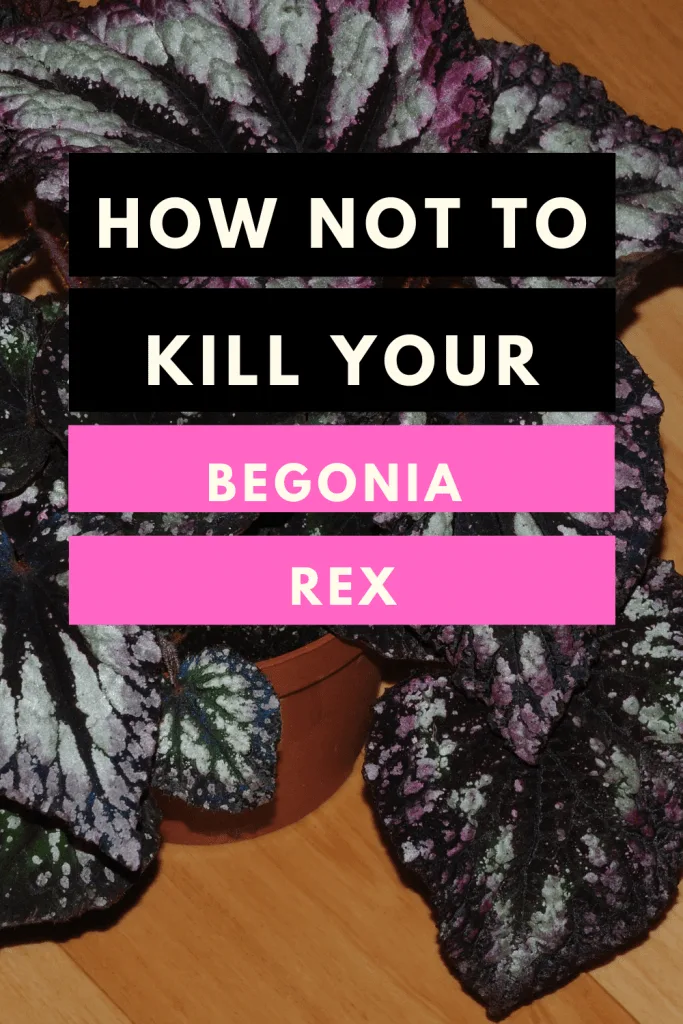
1. Begonia rex soil
Keep a Rex Begonia plant’s soil moist. But doing this can mean accidentally over-watering your plant, which makes using fast-draining soil super important.
When it comes to fast-draining soil, porous soil works the best.
Porous soil allows excess water to drain instead of holding onto all that unneeded water. Over-watering can make your plant sick and fast.
Begonia rex potting mix:
- potting soil
- peat moss
- perlite
- vermiculite
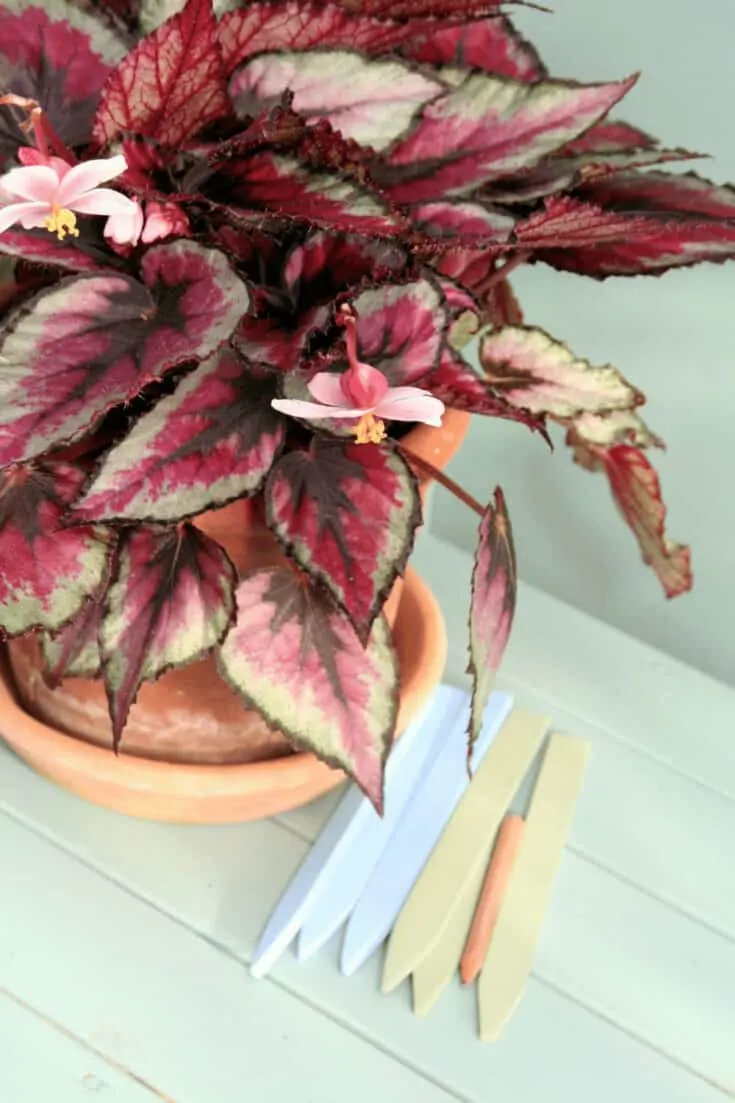
2. Rex begonia light
The Rex Begonia requires bright but indirect sunlight. This plant is only a semi-tropical plant.
Its beautiful leaves are sensitive to direct sunlight.
Direct sunlight can cause damage to this plant. The most common affliction from too much direct sunlight is the scorching of leaves. The scorch marks can be either dark or white.
Place your plant in the shade if grown outdoors.
Place your Rex begonia in either a north or east-facing window to get bright indirect light indoors.
Your plant will get plenty of sun but it won’t receive direct sunlight.
Don’t forget to rotate your plant whenever possible, so all parts are getting equal amounts of light.
You can also use artificial lights for this Begonia.
Make sure you sit your plant a few inches away instead of sitting it right under the light.
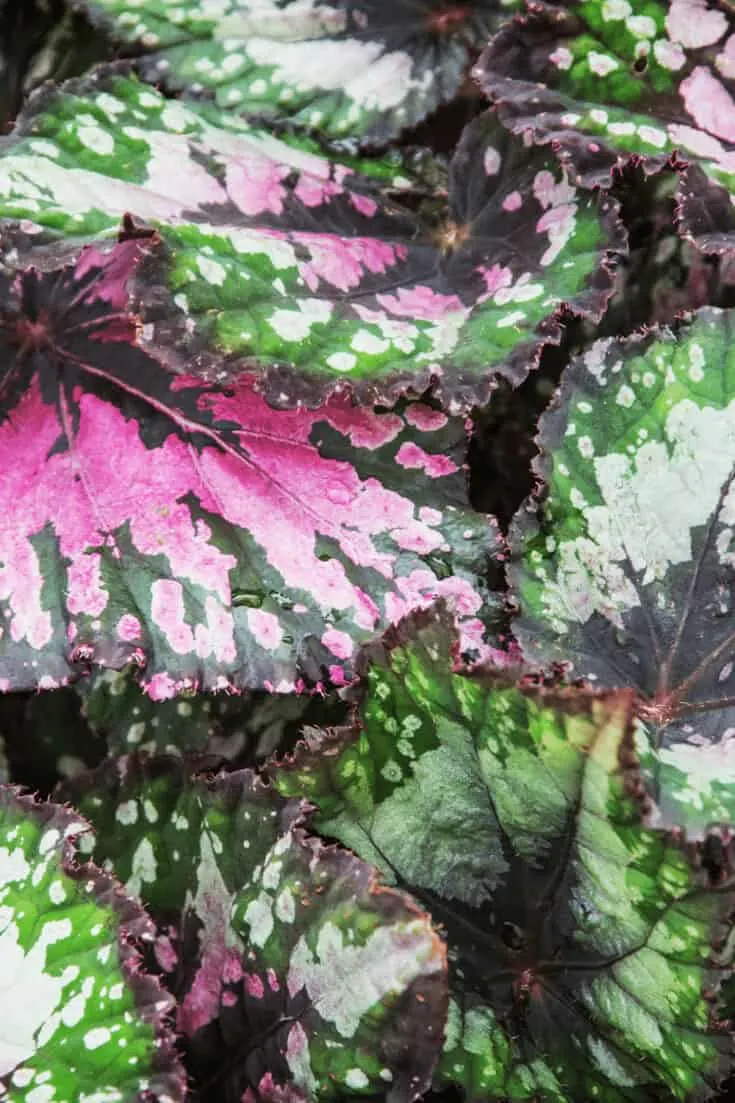
3. Watering
The soil for your Begonia should always be moist.
You should only allow the top inch or so of the soil to dry out before you water.
You can test the moisture with your finger.
Be careful not to over-water your plant, though. It’s easy to do, especially when keeping the soil moist.
The biggest plant disease you want to avoid from over-watering is root rot. It’s also the most common issue you’ll come across. This plant disease can destroy a plant.
Other common problems caused by over-watering include yellowing leaves, fungi, and stunted growth.
Keep in mind you’ll want to use distilled water for this plant.
The Rex Begonia originates in areas without salt in the water.
So, the salt build-up is easy to do.
Tap water contains salt and other chemicals that can harm your plant.
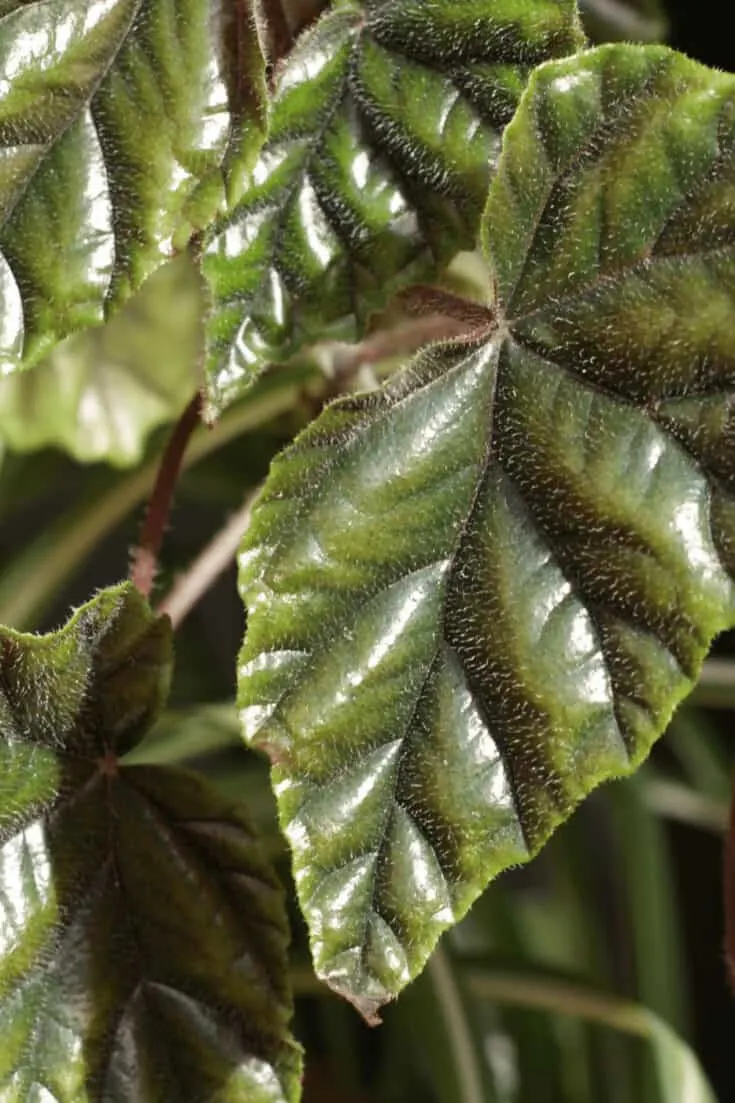
4. Temperature
The temperature should be between 65-75°F (18-24°C).
At night, the temperature should never drop below 60F (16C).
You should avoid freezing temperatures at all times. This plant dislikes cold temperatures. It can harm or even kill your plant.
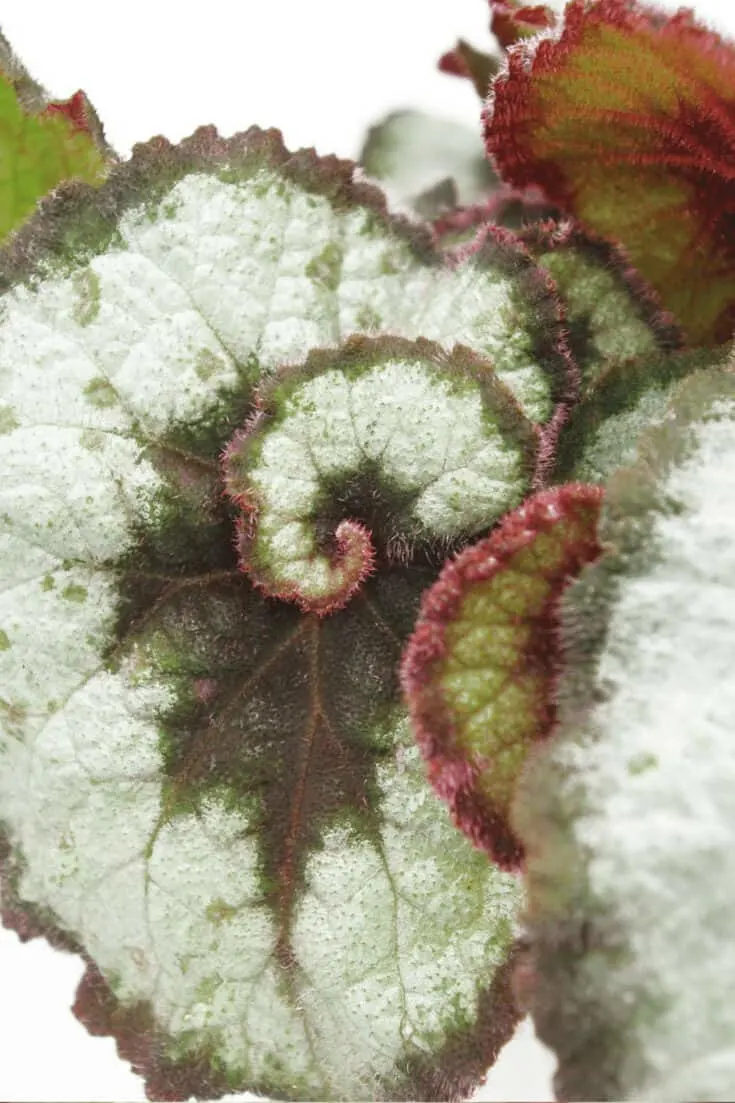
5. Rex begonia humidity
Begonia rex prefers 50% humidity.
High humidity isn’t necessary for a Rex begonia.
But the air in the plant’s environment can’t be dry. Even though high humidity isn’t required, it keeps the plant full, lush, and healthy.
There are several ways to create humidity for any indoor plant. The easiest method is to buy a humidifier. Humidifiers allow you to adjust the humidity as needed. But they can get pricey.
Another method involves spritzing the leaves of your plant now and then. When the water evaporates, it creates moisture in the air.
I am personally against misting the leaves of plants manually as mist on the leaves can cause leaf rot if the airflow is not sufficient to dry them quickly.
There is a major downside to spritzing the Rex Begonia. If you do this too often, it can create powdery mildew. Begonias are prone to mildew and mold.
One of our favorite methods for creating high humidity is the pebble tray method. This is an easy method, and it doesn’t cost much.
You may have everything you need at home already.
You start by filling a tray with smooth pebbles. Then go ahead and fill the tray with water.
The water shouldn’t flow over the pebbles. It should sit right under the top layer. Now, set your plant on the pebbles.
You’ll only need to refill the tray with water once it’s empty. The water will evaporate over time, keeping humidity in the air at all times.
This moisture goes straight to your plant since it sits atop the water source.
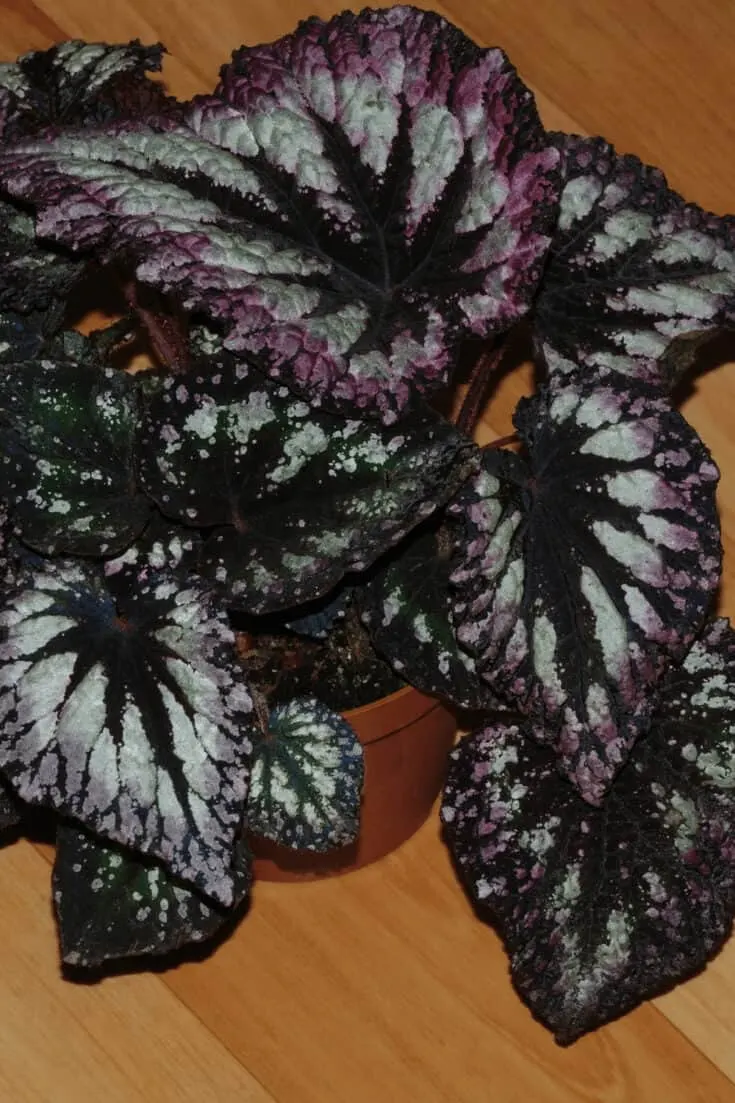
6. Fertilizer
For a Begonia, use regular houseplant fertilizer at half strength every two to three weeks in spring and summer.
You should only fertilize this plant during the growing season when new growth emerges. Once fall hits, the plant goes dormant. This means it won’t absorb the fertilizer.
The salt from the fertilizer can build up in the soil, causing serious fertilizer burn. This can harm Begonia’s roots as well as the leaves.
7. Propagation
There are two main ways to propagate a Rex Begonia. You’ll want to use the root division process for the best results. But you can also propagate this plant through leaf cuttings.
We’ll walk you through both methods step-by-step down below.
8. Growth
A Rex Begonia can grow to be 12 to 18 inches in height. The leaves on this plant can grow to about 6 inches in width.
9. Potting
Regarding the Rex Begonia, you want to repot in a shallow pot. Rex Begonia plants are rhizomatous plants.
They need room to spread. Unlike other houseplants, bigger plant pots are better.
Once you see the plant roots coming through the pot’s drainage holes, it’s time to re-pot it.
Always be careful during this process, you don’t want to damage the Rex Begonia plant’s roots.
10. Rex Begonia Propagation Steps
Propagating a Begonia rex doesn’t have to be complicated. It’s usually an easy process if you know what steps to take.
I am going to walk you through how to propagate Begonia using root division and through leaf cuttings.
Propagation Using Root Division
- The first thing you do is to dig up your Rex Begonia plant. You want to be careful during this process to avoid injuring the plant’s roots.
- Once your plant is soil-free, you must wash off the roots. This makes them easier to work with because they’re easier to see. The easiest way is to run a faucet or hose over the roots. Make sure the water isn’t running full blast.
- You need to remove all dead or harmed roots right away. This stops any plant disease from spreading. You can use a pair of sterilized pruning shears to do this.
- Most of the time, the roots should be easy to divide by hand. If you’re afraid to damage the roots, use pruning shears for this step. Make sure you sterilize the pruning shears with isopropyl alcohol.
- Lay the plant’s roots on a paper towel. Let them dry before you head on to the next step.
- Since you must wait for the roots to dry, prepare the plant pot. It should have drainage holes. Fill the plant pot with porous and fast-draining soil.
- Once the roots have dried, it’s time to plant them. The roots should be completely covered in soil.
- Now you care for the new plant like you do the mother, Rex. Make sure the soil is always moist. And make sure your plant is always getting bright but indirect sunlight.
Propagation Using Leaf Cuttings
- When you cut a leaf, make sure the leaf-cutting has three inches of the petiole attached. Use a pair of sterilized pruning shears to get your leaf cutting.
- Dip the cut end in a rooting hormone. This will double the chance of being successful with propagation.
- Get the plant pot ready. This plant pot should have drainage holes on the bottom. And the soil should be porous and fast-draining soil.
- Once the plant pot is ready to go, you can go ahead and plant the leaf-cutting. Place the leaf-cutting, so it’s sticking out of the soil at a 45-degree angle. Make sure you pack the soil tightly around the cutting. This will help make it stand up.
- Protecting your leaf cutting from harm while it starts to root is important. Plus, you want to trap in moisture so it’ll grow quicker. To do this, you want to cover the leaf-cutting in plastic wrap. You can use tape to keep the plastic wrap to the cutting. Don’t remove the plastic wrap until a few new leaves have grown.
- You can care for the leaf-cutting as you do the original Begonia rex. It should be getting bright indirect light. The soil should always be moist.
Alternatively, you can propagate using water as a medium for Begonias.
Varieties of Begonias
Begonias are some of my favorite indoor plants.
And the Begonia rex isn’t the only wonder species out there.
Here are some other cool Begonia species to check out.
Begonia tuberous
The Begonia tuberous plant creates beautiful pink flowers. These flowers have a slight resemblance to roses. They’re perfect for the pastel plant lover.
Begonia rhizomatous
This Begonia species have leaves with a fun fuzzy feel. They come in various colors, the most common color being green.
Begonia cane
This Begonia creates both gorgeous leaves and flowers.
The leaves are narrow and spotted white. The flowers can turn orange, pink, and white.
Begonia fimbriata
These begonias have gorgeous flowers with frilly edges. They bloom in several colors, including pink, orange, and red.
Common Problems with the Begonia Rex (Pests and Diseases)
There are a few plant pests that love the Begonia rex. The bright side is if you find an infestation early, it’s easy to get rid of.
Plus, there will be minimal damage to your plant.
Mealybugs are the biggest plant pest problem with this Begonia. You’ll know you have a mealybug infestation if you see cotton fluff covering your plant.
These strange plant pests are soft-bodied. But they’re covered in a cotton-like substance that protects them from outside forces.
Mealybugs like to feed on the sap from the inside of a plant. This means they steal the hydration and nutrition from the plant.
Spider mites love Begonias as well. These mites aren’t actual insects but arachnids instead. They’re tiny and hard to detect.
But if you place a piece of paper under your plant and shake it, you should see them fall.
Spider mites also feed on the sap from your plant. A small infestation isn’t a big deal; once it grows, your plant can be in big trouble.
The biggest way to prevent plant pests is to examine all new plants before you bring them into your home. Pests love hopping from one plant to another.
Another way to prevent pests is to remove dead or dying leaves right away permanently.
To get rid of an infestation naturally, you should try neem oil. It’s a natural oil and isn’t known to harm many plants. But you should always test a small area of your plant to be on the safe side.
You need to dilute the neem oil with water. Then you can use the mix to spray down your plant. It suffocates the pests within only minutes. You’ll want to repeat this process about three days later.
When an infestation is too big for you to handle, consider pesticides. They should always be your last resort because they contain chemicals that can harm the environment.
Tips for an Unhappy Begonia Rex
Like many other Begonias, the Begonia rex is susceptible to several plant issues. It’s important to pay careful attention to your plant so you can fix any problems as they arise.
Here are some tips for the most common plant problems you’ll encounter.
Your Begonia Rex has Crispy Leaves or is Losing Leaves
A Begonia rex fools many plant lovers with dry leaves. They assume that the plant needs more water. So, they water the plant more and more.
The truth is, dry leaves are a sign of over-watering.
You want to switch out the saturated soil for fresh, moist soil. And always make sure the first inch of soil is dry before you water your Begonia rex.
You’ll also want to check the roots to ensure root rot hasn’t started.
If it has, remove the rotten roots. But if all the roots are rotten, there isn’t anything you can do for the plant.
Your Begonia Rex has Silver or Grey Spores
Begonia rex plants can quickly get mildew or fungal diseases. If you see silver or grey spores on your plant, it has Botrytis Blight disease.
Blight plant disease is challenging to battle. According to Cornell University, your Begonia is susceptible to this disease in wet or humid environments.
To treat this disease, remove all infected leaves on the plant. Get rid of these infected leaves right away.
This is to prevent the spread of spores and fungi. You should also make sure there’s good air circulation near your plant. Remove the diseased leaves.
Consider using a systemic fungicide. They’re full of chemicals, so it’s important to test an area of your plant before using it.
Your Begonia Rex has a White Powdery Substance
Begonia rex plants are prone to mildew and fungi.
You deal with powdery mildew when you see a white powdery substance all over your plant. Powdery mildew is a pain to get rid of, but it’s possible with a lot of effort.
You have to remove all the infected leaves, so it doesn’t spread. You’ll also need to make sure there’s plenty of air circulation.
A great way to prevent powdery mildew is through a spray mix you can make at home.
Mix a tablespoon of baking soda, a tablespoon of canola oil, and a tablespoon of dish soap. Spray your plant down every three weeks or so.
Rex Begonia for Sale
Rex begonias can be bought at the following online retailers: Logees, Amazon and Etsy, and many other online and offline shops.
Begonia rex varieties
There are wide different Begonia rex varieties available:
- ‘Pink Charming’
- ‘Fireworks’
- ‘Solar Flare’
- ‘Madame Queen’
- ‘Angel Wing’
- ‘Plum Paisley’
- ‘Green Gold’
- ‘Curl’
- ‘Stained Glass’
- ‘Celia’
- ‘Yamileth’
- ‘Bubbles’
- ‘Marmaduke’
- ‘Escargot’
- ‘Harmony Black Beauty’
- ‘Red Kiss’
- ‘Flamenco’
- ‘Northern Lights’
- ‘Salsa’
- ‘Rumba’
- ‘Amelia’s Kaleidoscope’
- ‘Ballet’
- ‘Duarten’
- ‘Silver Limbo’
- ‘Cowardly Lion’
- ‘Red Tango’
- ‘River Nile’
- ‘Blueberry Sorbet’
- ‘Spitfire’
- ‘Tornado’
Rex begonia identification
Begonia rex has vibrant foliage that ranges from red to green to purple with various patterns. Its leaves can be almost round, angel-wing shaped, or any other form. The leaves are hairy and wavy. The Rex begonia is a rhizomatous plant with stems creeping on the surface.
Begonia Rex Toxic
Begonia rex is toxic to pets such as cats, dogs, and horses, according to ASCPA. It contains Soluble calcium oxalates. Ingestions may lead to vomiting, kidney failure in grazing animals, and salvation in cats and dogs.
The most toxic parts of this plant grow underground.
Frequently Asked Questions
Is the Begonia rex plant toxic to animals?
The Begonia rex is toxic to cats, dogs, and horses. This is because the leaves are covered in calcium oxalate crystals. It can affect the animal’s breathing and cause excessive drooling. In worst-case scenarios, it can kill your pet.
Why are the leaves on my Begonia rex fading?
Fading leaves on a Begonia rex indicate too much direct sunlight. Move your plant to a shadier area. Make sure the sun or artificial light isn’t shining right on the plant.
How many Begonia rex plants can I put in one pot?
Plant one Begonia rex per pot. These plants can grow wide. If there are several plants in one pot, they will crowd together.
Conclusion About Begonia Rex Care
Use a well-draining soil mix to care for Begonia rex and provide bright indirect light. Water once the to 1-inch of soil is dry once a week. Make sure the plant never dries out. The best temperature is 65-75°F (18-24°C). Provide 50% or more humidity and fertilize every three weeks using a liquid fertilizer diluted to 1/2 strength.

